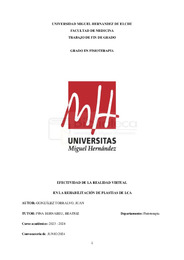Por favor, use este identificador para citar o enlazar este ítem:
https://hdl.handle.net/11000/33588Registro completo de metadatos
| Campo DC | Valor | Lengua/Idioma |
|---|---|---|
| dc.contributor.advisor | Pina Bernabeu, Beatriz | - |
| dc.contributor.author | González Torralvo, Juan | - |
| dc.contributor.other | Departamentos de la UMH::Patología y Cirugía | es_ES |
| dc.date.accessioned | 2024-10-22T09:24:06Z | - |
| dc.date.available | 2024-10-22T09:24:06Z | - |
| dc.date.created | 2024-05-30 | - |
| dc.identifier.uri | https://hdl.handle.net/11000/33588 | - |
| dc.description.abstract | Introducción: El LCA es crucial para la estabilidad y propiocepción de la rodilla. Su lesión es frecuente y puede optarse por tratamiento conservador o quirúrgico. Destacamos el uso de RVI como herramienta de rehabilitación post-ACLR, utilizando gafas de realidad virtual o salas especializadas para simular entornos clínicos más atractivos mediante estimulación sensorial, intentando restablecer ciertas habilidades. Objetivos: 1) Analizar la influencia comparando los efectos de la RVI en la rehabilitación de pacientes post-ACLR. 2) Observar qué parámetros son más efectivos. Material y métodos: Se ha realizado una revisión bibliográfica en las bases de datos Pubmed, Scopus, Google scholar y Cochrane, extrayendo 5 artículos para su posterior estudio y análisis, especificando contenido, medición y resultados. Resultados: 1) El 60% de los estudios evaluó movilidad articular, encontrando una mejora significativa en el 66,66% de los casos. La propiocepción y estabilidad mejoraron en el 100% de los estudios que las midieron (40%). No hubo diferencias en el equilibrio dinámico, reparto de cargas y apoyo, pero si en saltos unilaterales, VGRF y valgo de rodilla. También se observó una mejora en el dolor y en la puntuación de la escala IK2000. 2) Se incluyen programas de entre 8 y 24 semanas acompañado de rehabilitación convencional, con una media de 3,12 sesiones por semana y 28,33 minutos de duración. Conclusiones: A pesar de que falte evidencia científica que respalde esta herramienta de tratamiento y no haya unos parámetros específicos, la RVI obtiene resultados clínicamente favorables. | es_ES |
| dc.description.abstract | Introduction: The ACL is crucial for knee stability and proprioception. It is frequently injured and can be treated conservatively or surgically. We highlight the use of RVI as a post-ACLR rehabilitation tool, using virtual reality glasses or specialized rooms to simulate more attractive clinical environments through sensory stimulation, trying to restore certain skills. Objectives: 1) To analyze the influence by comparing the effects of IVR on the rehabilitation of post-ACLR patients. 2) To observe which parameters are more effective. Material and methods: A literature review was carried out in the Pubmed, Scopus, Google scholar and Cochrane databases, extracting 5 articles for subsequent study and analysis, specifying content, measurement and results. Results: 1) 60% of the studies evaluated joint mobility, finding a significant improvement in 66.66% of the cases. Proprioception and stability improved in 100% of the studies that measured them (40%). There were no differences in dynamic balance, load distribution and support, but there were differences in unilateral jumps, VGRF and knee valgus. An improvement in pain and in the IK2000 scale score was also observed. 2) Programs of between 8 and 24 weeks accompanied by conventional rehabilitation were included, with an average of 3.12 sessions per week and 28.33 minutes in duration. Conclusions: Despite the lack of scientific evidence to support this treatment tool and the absence of specific parameters, IVR obtains clinically favorable results. | es_ES |
| dc.format | application/pdf | es_ES |
| dc.format.extent | 38 | es_ES |
| dc.language.iso | spa | es_ES |
| dc.publisher | Universidad Miguel Hernández | es_ES |
| dc.rights | info:eu-repo/semantics/openAccess | es_ES |
| dc.rights | Attribution-NonCommercial-NoDerivatives 4.0 Internacional | * |
| dc.rights.uri | http://creativecommons.org/licenses/by-nc-nd/4.0/ | * |
| dc.subject | Ligamento cruzado anterior | es_ES |
| dc.subject | realidad virtual | es_ES |
| dc.subject | ejercicio físico | es_ES |
| dc.subject | rehabilitación | es_ES |
| dc.subject.other | CDU::6 - Ciencias aplicadas | es_ES |
| dc.title | Efectividad de la realidad virtual en la rehabilitación de plastias de LCA | es_ES |
| dc.type | info:eu-repo/semantics/bachelorThesis | es_ES |

Ver/Abrir:
GONZÁLEZ TORRALVO, JUAN.pdf
706,45 kB
Adobe PDF
Compartir:
 La licencia se describe como: Atribución-NonComercial-NoDerivada 4.0 Internacional.
La licencia se describe como: Atribución-NonComercial-NoDerivada 4.0 Internacional.
.png)